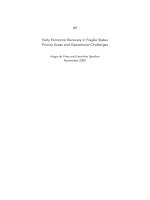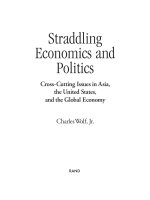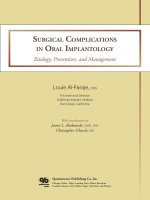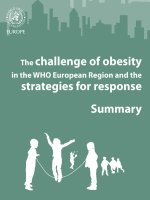Haematological alterations in broilers administered with imidacloprid and spinosad and its amelioration with vitamin E and silymarin
Bạn đang xem bản rút gọn của tài liệu. Xem và tải ngay bản đầy đủ của tài liệu tại đây (151.3 KB, 5 trang )
Int.J.Curr.Microbiol.App.Sci (2017) 6(4): 496-500
International Journal of Current Microbiology and Applied Sciences
ISSN: 2319-7706 Volume 6 Number 4 (2017) pp. 496-500
Journal homepage:
Original Research Article
/>
Haematological Alterations in Broilers Administered with Imidacloprid and
Spinosad and Its Amelioration with Vitamin E and Silymarin
V. Ravikanth1*, M. Lakshman2, D. Madhuri1 and B. Kalakumar3
1
Department of Veterinary Pathology, C.V.Sc, Korutla, India
RUSKA Labs, Department of Veterinary Pathology, C.V.Sc, Hyderabad, India
3
Department of Veterinary Pharmacology and Toxicology, C.V.Sc, Hyderabad, India
2
*Corresponding author
ABSTRACT
Keywords
Imidacloprid,
Spinosad, Male
Cobb broilers,
Toxicity,
Hematological
parameters.
Article Info
Accepted:
02 March 2017
Available Online:
10 April 2017
The present study was aimed to know the heamatological alteration due to imidacloprid
and spinosad (neonicotinoid and bacterial insecticide respectively) and their amelioration
with vitamin E and silymarin in male Cobb broiler chicken. The experiment was carried
out for 28 days. Group 1 served as control, group 2 treated with imidacloprid @ 50 ppm in
feed, group 3 was treated with spinosad @ 1000 ppm in feed, group 4 was treated with
imidacloprid @ 50 ppm and spinosad @ 1000 ppm in feed, group 5 was treated with
imidacloprid @ 50 ppm, spinosad @ 1000 ppm and Vitamin E @ 20 ppm in feed and
group 6 was treated with imidacloprid @ 50 ppm, spinosad @ 1000 ppm and silymarin @
1000 ppm in feed. The weekly body weight gains were significantly (P < 0.05) decreased
in groups 2, 3 and 4, 5 and 6. Haematological observations revealed a significant (P <
0.05) decrease in overall means of TEC, Hb concentration, MCV, MCH, MCHC and PCV
except TLC in groups 2, 3 and 4, 5 and 6 in which there is a significant (P < 0.05) increase.
These results revealed that exposure of imidacloprid, spinosad and its combination resulted
in alterations in haematological parameters.
Introduction
the resume of success of green revolution the
usage of insecticides and pesticides has been
enormously increased in grain crop
cultivation. However, their indiscriminate use
lead to widespread concern because of their
potential adverse effect on animal and human
health (Al-saleh, 1994). Among all spinosad
which is a bacterial insecticide introduced in
market in 1997 has high efficacy, with broad
insect pest spectrum, low mammalian toxicity
and a good environmental profile, which is
having a unique feature of the insecticides
that are currently used for the protection of
grain products (Hertlain et al., 2011).
Earlier poultry was restricted to households
only, but with a huge increase in demand for
poultry products like chicken and eggs are
attributed to increasing population with
improved scientific knowledge; now poultry
has grown into an industry which is
contributing to the state economy. The output
of the poultry industry is dependent on the
source of balanced feed availability. As per
NRC (1994) recommendations major portion
of feed should contain grains like maize and
sorghum as a source of energy and soya,
groundnut and cotton seed cake as a source of
vegetable protein. Over a period of time, in
496
Int.J.Curr.Microbiol.App.Sci (2017) 6(4): 496-500
Imidacloprid is a potent and most widely used
insecticide introduced in the market in 1991
(Yamamoto and Casida, 1999). In view of the
significant adverse effects induced by SPD
and IM, the current study was designed to
observe and evaluate the mixed toxicity and
its effect in broiler chicken and to study the
ameliorative effect of vitamin E and silymarin
to overcome the mixed toxic effects.
Growth rate
Materials and Methods
Collection of blood for haematological
parameters
Individual body weights of all the birds were
recorded by using electronic balance on day
one and subsequently on 7th, 14th, 21st and
28th day of experiment to study the body
weight gains.
Haematology
In the present experiment, a total of 120 day
old male broiler chicks (Cobb strain)
weighing between 32 -34 g were procured
from a commercial hatchery. On arrival, the
chicks were individually weighed, wing
banded and divided into six groups of 20
each. The chicks were housed in battery
brooders located at poultry experimental
station (PES) and maintained under identical
conditions throughout the course of
experiment. The experiment was conducted
with prior approval of the Institutional
Animal Ethics Committee (IAEC).
From each group, 6 birds were sacrificed on
14th day and remaining was sacrificed on
28th day. The selected birds were put to fast
for 12 hours a day before sacrifice, 3 ml of
blood was collected from wing vein in an
anticoagulant coated vaccutainers [(K3EDTA tube, 13mm x 75mm, 4ml (Rapid
Diagnostics Pvt, Ltd., Delhi)] to carry out all
haematological
parameters
viz.
Total
erythrocyte count (TEC), Total leukocyte
count
(TLC),
Haemoglobin
(Hb)
concentration, Packed cell volume (PCV),
Mean corpuscular hemoglobin (MCH), Mean
Corpuscular Volume (MCV) and Mean
corpuscular
hemoglobin
concentration
(MCHC) by using automatic whole blood
analyzer (Huma count, med source ozone
biochemical Pvt. Ltd) and the results obtained
were tabulated for statistical analysis by
applying one way ANOVA using statistical
package for social sciences (SPSS) version
16.0. Differences between means were tested
by using Duncan‟s multiple comparison tests
and significance level was set at P < 0.05
(Snedecor and Cochran, 1994).
The experimental design adopted for the
present study is shown in table 1.
All birds have free access to fresh feed and
water ad libitum throughout the experimental
period.
Chemicals
Imidacloprid was procured from a wholesale
pesticide outlet in Hyderabad under the trade
name victor plus (70% Imidacloprid),
similarly Spinosad was also procured and the
trade name is Spinctor (45% Spinosad)
manufactured by Bayer India Pvt. Ltd.,
Maharashtra. Vitamin E was obtained from
Merck Company and Silymarin was
purchased from a medical outlet under the
trade name silybon-140 (each tablet contains
140mg of Silymarin).
Results and Discussion
The present study was carried out to study the
individual and mixed toxic effects of
imidacloprid and spinosad in birds and their
amelioration with vitamin E and silymarin.
497
Int.J.Curr.Microbiol.App.Sci (2017) 6(4): 496-500
PCV, MCV, MCH and MCHC in group 2, 3
and 4 when compared to control and
numerical increase is noticed in group 5 and 6
compared to group 4 which is statistically
insignificant (Tables 3 and 4). These
observations were similar to the findings of
Yano et al., (2002), Mansour et al., (2007)
and Soujanya et al., (2013) in different
animals at different dose and time intervals.
In the present study, decreased values of TEC,
Hb, PCV, MCV, MCH, and MCHC could be
due to the toxic effects of IM, SPD and its
combination as direct action on bone marrow,
liver and kidney which might play a vital role
in haemopoiesis and erythropoietin (EPO)
production in respective organs.
Body weight
There is a significant reduction in body
weight in group 2,3 and 4 when compared to
control This decrease in body weight gain is
due to decreased feed and water intake as a
result of hepato, renal toxicity. The findings
in group 2 and 3 are in agreement with
Sasidhar Babu et al., (2014) and Mansour et
al., (2007). In amelioration groups i.e. group
5 and 6 showed a significant improvement in
comparison with group 4 indicating the
protective action of ameliorating agents.
Haematological parameters
There is a significant (P < 0.05) decrease in
haematological parameters like TEC, Hb,
Table.1 The experimental design
GROUP
1
2
3
4
No. of birds
20
20
20
20
5
20
6
20
Treatment
Control
Imidacloprid @ 50 PPM in feed
Spinosad @ 1000 PPM in feed
Imidacloprid @ 50 PPM + Spinosad @ 1000 PPM
in feed
Imidacloprid @ 50 PPM + Spinosad @ 1000 PPM +
Vitamin E @ 20 PPM in feed
Imidacloprid @ 50 PPM + Spinosad @ 1000 PPM +
Silymarin @ 1000 PPM in feed
Table.2 Weekly body weight gain (g) in different groups
Group
Group 1
Group 2
Group 3
Group 4
Group 5
Group 6
P value
Day 7
110.88±1.28a
100.9±1.96b
100.05±2.19b
87.53±4.78c
99.03±1.02b
97.55±2.79b
*
Day 14
156.6±8.72a
126.27±8.33b
125.15±2.85b
100.6±10.54c
123.72±3.49b
123±5.25b
*
Day 21
367.68±16.17a
312.61±17.64b
297.66±7.37b
202.62±18.91c
256.55±25.66b
264.76±14.99b
*
Values are Mean ± SE (n=6); one way ANOVA
Means with different superscripts in a column differ slightly at P<0.05 (*).
498
Day 28
366.28±31.55a
264.34±6.85b
264.11±2.96b
204.86±4.04c
276.70±28.53b
273.51±15.38b
*
Int.J.Curr.Microbiol.App.Sci (2017) 6(4): 496-500
Table.3 Hematological parameters (TEC, Hb and PCV) in different groups at different time
intervals
Group
TEC
Group 1
Group 2
Group 3
Group 4
Group 5
Group 6
P value
Day 14
2.53±0.03a
2.24±0.04b
2.22±0.09b
2.06±0.04c
2.11±0.04bc
2.09±0.04bc
*
Hb
Day 28
2.47±0.03a
2.28±0.05b
2.27±0.02b
2.05±0.10c
2.16±0.05bc
2.14±0.05bc
*
PCV
Day 14
10.73±0.32a
9.53±0.28b
9.43±0.26b
9.02±0.35b
9.68±0.31b
9.65±0.40b
*
Day 28
12.57±0.27a
11.43±0.41b
11.28±0.30b
10.53±0.35b
11.40±0.26b
11.35±0.33b
*
Day 14
36.10±0.21a
32.88±0.59b
31.82±1.60b
30.65±0.88b
31.67±0.95b
32.55±1.27b
*
Day 28
35.20±0.57a
32.60±0.56b
32.37±0.54b
29.85±0.68c
32.00±1.15bc
31.88±0.67bc
*
Values are Mean ± SE (n=6); one way ANOVA
Means with different superscripts in a column differ slightly at P<0.05 (*).
Table.4 Evaluation of MCV, MCH and MCHC in different groups at different time Intervals
Group
MCV
Group 1
Group 2
Group 3
Group 4
Group 5
Group 6
P value
Day 14
142.98±0.94a
136.82±1.15b
136.37±1.52b
133.12±0.95b
135.07±1.95b
134.80±1.79b
*
MCH
Day 28
146.03±0.36a
141.77±0.65b
141.27±0.65b
138.60±1.43b
139.17±1.03b
139.13±1.99b
*
Day 14
44.05±0.38a
40.02±0.44b
40.22±0.30b
38.55±0.19c
39.50±0.18bc
39.30±0.75bc
*
MCHC
Day 28
51.27±0.30a
49.38±0.49b
49.22±0.21b
47.58±0.69c
48.87±0.49bc
48.58±0.57bc
*
Day 14
32.12±0.27a
29.70±0.54b
29.77±0.21b
28.53±0.19c
29.18±0.22bc
28.97±0.29bc
*
Values are Mean ± SE (n=6); one way ANOVA
Means with different superscripts in a column differ slightly at P<0.05 (*).
Table.5 Total Leucocytes Count (thousands/Cmm) in different groups
Group
Group 1
Group 2
Group 3
Group 4
Group 5
Group 6
P value
Day 14
25.43±0.24c
27.53±0.61b
27.70±0.70b
31.75±1.14a
30.12±0.43a
30.43±0.74a
*
Day 28
27.15±0.25d
29.63±0.79c
29.98±0.77bc
34.03±0.75a
32.02±1.30ab
32.38±0.40a
*
Values are Mean ± SE (n=6); one way ANOVA
Means with different superscripts in a column differ slightly at P<0.05 (*).
499
Day 28
36.15±0.34a
35.23±0.20b
35.20±0.24b
34.17±0.30c
34.62±0.43bc
34.38±0.30bc
*
Int.J.Curr.Microbiol.App.Sci (2017) 6(4): 496-500
A significant (P < 0.05) increase in TLC was
found in group 2, 3, 4, 5 and 6 treated birds
when compared to control which might be
due to the activation of leucopoiesis due to
administration of intoxicants, which might act
as an immunosuppressive agents at this level
(Table 5). These findings were in accordance
with Yano et al., (2002), Mansour et al.,
(2007) and Soujanya et al., (2013) which
were recorded in rats at different dosage for
different time intervals.
insecticide Spinosad on male albino
rats. Int. J. Agri. Biol., 9(2): 342-346.
NRC. 1994 Nutrient Requirements of poultry.
National Academy press, Washingtion,
DC.
Sasidhar Babu, N., Kumar, A.A., Reddy,
A.G., Amaravathi, P. and Hemanth, I.
2014. Chronic experimental feeding of
imidacloprid induced oxidative stress
and amelioration with vitamin C and
Withania somnifera in layer birds. Int.
J. Sci. Environ. ISSN and Technol.,
3(5): 1679 – 1684.
Snedecor, G.W. and Cochran, G. 1994.
Statistical methods, 8th ed., IOWA
State University Press, Amer, IOWA,
USA.
Soujanya, S., Lakshman, M., Kumar, A.A.
and Reddy, A.G. 2013. Evaluation of
the protective role of vitamin C in
imidacloprid-induced hepatotoxicity in
male Albino rats. J. Natural Sci. Biol.
Med., 4(1): 67.
Yamamoto, I. and Casida, J. 2009. Nicotinoid
Insecticides
and
the
Nicotinic
Acetylcholine Receptor. SpringerVerlag: 3–27.
Yano, B.L., Bond, D.M., Novilla, M.N.,
McFadden, L.G. and Reasor, M.J. 2002.
Spinosad insecticide: Sub-chronic and
chronic
toxicity
and
lack
of
carcinogenicity in Fischer 344 rats.
Toxicol. Sci., 65(2): 288-298.
In conclusion IM, SPD and its combination
resulted in mild, marked and severe
hematological changes at different time
intervals. The present dose levels (IM @ 50
ppm and SPD @ 1000ppm) were found to be
toxic in nature. The co-administration of
vitamin E and silymarin @ 20 and 1000 ppm
revealed mild improvement in all the above
parameter as a part of initiation in repair and
regeneration.
References
Al-saleh, I.A. 1994. Pesticides: A review
article. J. Environ. Pathol. Toxicol.
Oncol., 13: 151-161.
Hertlein, M., Gary, D.T., Bhadriraju, S. and
Christos, G.A. 2011. "Spinosad: A new
natural product for stored grain
protection". Stored Products, 47: 131–
146.
Mansour, S.A., Mossa, A.H. and Heikal, T.M.
2007. Haemotoxicity of a new natural
How to cite this article:
Ravikanth, V., M. Lakshman, D. Madhuri and Kalakumar, B. 2017. Haematological
Alterations in Broilers Administered with Imidacloprid and Spinosad and Its Amelioration with
Vitamin E and Silymarin. Int.J.Curr.Microbiol.App.Sci. 6(4): 496-500.
doi: />
500









